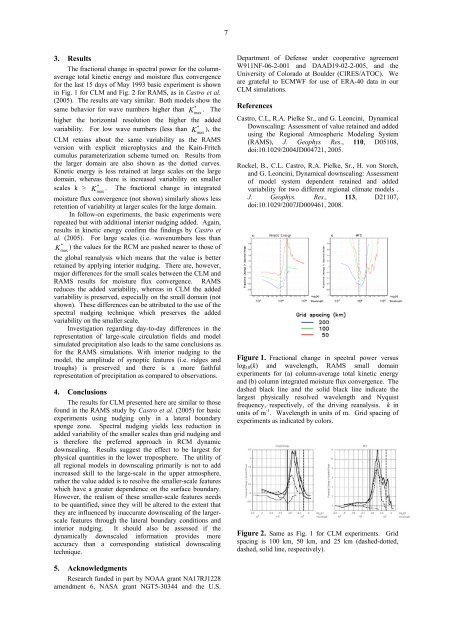Low (web) Quality - BALTEX
Low (web) Quality - BALTEX
Low (web) Quality - BALTEX
Create successful ePaper yourself
Turn your PDF publications into a flip-book with our unique Google optimized e-Paper software.
7<br />
3. Results<br />
The fractional change in spectral power for the columnaverage<br />
total kinetic energy and moisture flux convergence<br />
for the last 15 days of May 1993 basic experiment is shown<br />
in Fig. 1 for CLM and Fig. 2 for RAMS, as in Castro et al.<br />
(2005). The results are vary similar. Both models show the<br />
*<br />
same behavior for wave numbers higher than K . The<br />
max<br />
higher the horizontal resolution the higher the added<br />
*<br />
variability. For low wave numbers (less than K ), the<br />
max<br />
CLM retains about the same variability as the RAMS<br />
version with explicit microphysics and the Kain-Fritch<br />
cumulus parameterization scheme turned on. Results from<br />
the larger domain are also shown as the dotted curves.<br />
Kinetic energy is less retained at large scales on the large<br />
domain, whereas there is increased variability on smaller<br />
scales k > K<br />
* . The fractional change in integrated<br />
max<br />
moisture flux convergence (not shown) similarly shows less<br />
retention of variability at larger scales for the large domain.<br />
In follow-on experiments, the basic experiments were<br />
repeated but with additional interior nudging added. Again,<br />
results in kinetic energy confirm the findings by Castro et<br />
al. (2005). For large scales (i.e. wavenumbers less than<br />
*<br />
K ) the values for the RCM are pushed nearer to those of<br />
max<br />
the global reanalysis which means that the value is better<br />
retained by applying interior nudging. There are, however,<br />
major differences for the small scales between the CLM and<br />
RAMS results for moisture flux convergence. RAMS<br />
reduces the added variability, whereas in CLM the added<br />
variability is preserved, especially on the small domain (not<br />
shown). These differences can be attributed to the use of the<br />
spectral nudging technique which preserves the added<br />
variability on the smaller scale.<br />
Investigation regarding day-to-day differences in the<br />
representation of large-scale circulation fields and model<br />
simulated precipitation also leads to the same conclusions as<br />
for the RAMS simulations. With interior nudging to the<br />
model, the amplitude of synoptic features (i.e. ridges and<br />
troughs) is preserved and there is a more faithful<br />
representation of precipitation as compared to observations.<br />
4. Conclusions<br />
The results for CLM presented here are similar to those<br />
found in the RAMS study by Castro et al. (2005) for basic<br />
experiments using nudging only in a lateral boundary<br />
sponge zone. Spectral nudging yields less reduction in<br />
added variability of the smaller scales than grid nudging and<br />
is therefore the preferred approach in RCM dynamic<br />
downscaling. Results suggest the effect to be largest for<br />
physical quantities in the lower troposphere. The utility of<br />
all regional models in downscaling primarily is not to add<br />
increased skill to the large-scale in the upper atmosphere,<br />
rather the value added is to resolve the smaller-scale features<br />
which have a greater dependence on the surface boundary.<br />
However, the realism of these smaller-scale features needs<br />
to be quantified, since they will be altered to the extent that<br />
they are influenced by inaccurate downscaling of the largerscale<br />
features through the lateral boundary conditions and<br />
interior nudging. It should also be assessed if the<br />
dynamically downscaled information provides more<br />
accuracy than a corresponding statistical downscaling<br />
technique.<br />
Department of Defense under cooperative agreement<br />
W911NF-06-2-001 and DAAD19-02-2-005, and the<br />
University of Colorado at Boulder (CIRES/ATOC). We<br />
are grateful to ECMWF for use of ERA-40 data in our<br />
CLM simulations.<br />
References<br />
Castro, C.L, R.A. Pielke Sr., and G. Leoncini, Dynamical<br />
Downscaling: Assessment of value retained and added<br />
using the Regional Atmospheric Modeling System<br />
(RAMS), J. Geophys Res., 110, D05108,<br />
doi:10.1029/2004JD004721, 2005.<br />
Rockel, B., C.L. Castro, R.A. Pielke, Sr., H. von Storch,<br />
and G. Leoncini, Dynamical downscaling: Assessment<br />
of model system dependent retained and added<br />
variability for two different regional climate models .<br />
J. Geophys. Res., 113, D21107,<br />
doi:10.1029/2007JD009461, 2008.<br />
Figure 1. Fractional change in spectral power versus<br />
log 10 (k) and wavelength, RAMS small domain<br />
experiments for (a) column-average total kinetic energy<br />
and (b) column integrated moisture flux convergence. The<br />
dashed black line and the solid black line indicate the<br />
largest physically resolved wavelength and Nyquist<br />
frequency, respectively, of the driving reanalysis. k in<br />
units of m -1 . Wavelength in units of m. Grid spacing of<br />
experiments as indicated by colors.<br />
Figure 2. Same as Fig. 1 for CLM experiments. Grid<br />
spacing is 100 km, 50 km, and 25 km (dashed-dotted,<br />
dashed, solid line, respectively).<br />
5. Acknowledgments<br />
Research funded in part by NOAA grant NA17RJ1228<br />
amendment 6, NASA grant NGT5-30344 and the U.S.













